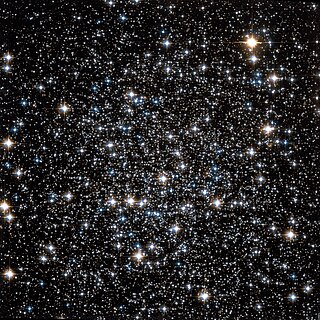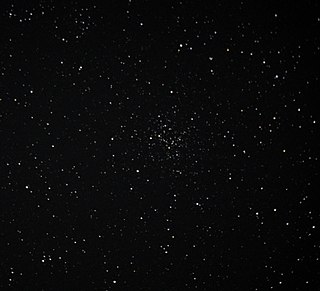Related Research Articles

Frederick William Herschel was a German-born British astronomer and composer. He frequently collaborated with his younger sister and fellow astronomer Caroline Herschel. Born in the Electorate of Hanover, William Herschel followed his father into the military band of Hanover, before emigrating to Great Britain in 1757 at the age of nineteen.

Sir John Frederick William Herschel, 1st Baronet was an English polymath active as a mathematician, astronomer, chemist, inventor, experimental photographer who invented the blueprint and did botanical work.

The New General Catalogue of Nebulae and Clusters of Stars is an astronomical catalogue of deep-sky objects compiled by John Louis Emil Dreyer in 1888. The NGC contains 7,840 objects, including galaxies, star clusters and emission nebulae. Dreyer published two supplements to the NGC in 1895 and 1908, known as the Index Catalogues, describing a further 5,386 astronomical objects. Thousands of these objects are best known by their NGC or IC numbers, which remain in widespread use.

Caroline Lucretia Herschel was a German-born British astronomer, whose most significant contributions to astronomy were the discoveries of several comets, including the periodic comet 35P/Herschel–Rigollet, which bears her name. She was the younger sister of astronomer William Herschel, with whom she worked throughout her career.
The year 1802 in science and technology involved some significant events, listed below.

Sir William Huggins was a British astronomer best known for his pioneering work in astronomical spectroscopy together with his wife, Margaret.

John Louis Emil Dreyer was a Danish astronomer who spent most of his career working in Ireland. He spent the last decade of his life in Oxford, England.

Omega Centauri is a globular cluster in the constellation of Centaurus that was first identified as a non-stellar object by Edmond Halley in 1677. Located at a distance of 17,090 light-years, it is the largest-known globular cluster in the Milky Way at a diameter of roughly 150 light-years. It is estimated to contain approximately 10 million stars, and a total mass equivalent to 4 million solar masses, making it the most massive-known globular cluster in the Milky Way.

Messier 110, or M110, also known as NGC 205, is a dwarf elliptical galaxy that is a satellite of the Andromeda Galaxy in the Local Group.

The Merope Nebula is a diffuse reflection nebula in the Pleiades star cluster, surrounding the 4th magnitude star Merope. It was discovered on October 19, 1859 by the German astronomer Wilhelm Tempel. The discovery was made using a 10.5cm refractor. John Herschel included it as 768 in his General Catalogue of Nebulae and Clusters of Stars but never observed it himself.

NGC 3603 is a nebula situated in the Carina–Sagittarius Arm of the Milky Way around 20,000 light-years away from the Solar System. It is a massive H II region containing a very compact open cluster HD 97950.
There are several astronomical catalogues referred to as Nebulae and Star Clusters.

NGC 17, also known as NGC 34, is a spiral galaxy in the constellation Cetus. It is the result of a merger between two disk galaxies, resulting in a recent starburst in the central regions and continuing starforming activity. The galaxy is still gas-rich, and has a single galactic nucleus. It lies 250 million light years away. It was discovered in 1886 by Frank Muller and then observed again later that year by Lewis Swift.

Sh2-279 is an HII region and bright nebulae that includes a reflection nebula located in the constellation Orion. It is the northernmost part of the asterism known as Orion's Sword, lying 0.6° north of the Orion Nebula. The reflection nebula embedded in Sh2-279 is popularly known as the Running Man Nebula.

NGC 1514 is a planetary nebula in the zodiac constellation of Taurus, positioned to the north of the star Psi Tauri along the constellation border with Perseus. Distance to the nebula is 466 pc, according to GAIA DR2 data.

NGC 288 is a globular cluster in the constellation Sculptor. Its visual appearance was described by John Dreyer in 1888. It is located about 1.8° southeast of the galaxy NGC 253, 37′ north-northeast of the South Galactic Pole, 15′ south-southeast of a 9th magnitude star, and encompassed by a half-circular chain of stars that opens on its southwest side. It can be observed through binoculars. It is not very concentrated and has a well resolved, large 3′ dense core that is surrounded by a much more diffuse and irregular 9′ diameter ring. Peripheral members extend farther outward towards the south and especially southwest.

NGC 2261 is a variable nebula located in the constellation Monoceros. The nebula is illuminated by the star R Monocerotis, which is not directly visible itself.

NGC 5053 is the New General Catalogue designation for a globular cluster in the northern constellation of Coma Berenices. It was discovered by German-British astronomer William Herschel on March 14, 1784 and cataloged as VI-7. In his abbreviated notation, he described it as, "an extremely faint cluster of extremely small stars with resolvable nebula 8 or 10′ diameter, verified by a power of 240, beyond doubt". Danish-Irish astronomer John Louis Emil Dreyer reported in 1888 that the cluster appeared, "very faint, pretty large, irregular round shape, growing very gradually brighter at the middle".

NGC 1466 is the New General Catalogue designation for a globular cluster in the deep southern constellation of Hydrus. It is located in the outskirts of the Large Magellanic Cloud, which is a satellite galaxy of the Milky Way. The object was discovered November 26, 1834 by English astronomer John Herschel. John Dreyer described it as "pF, pS, iR, glbM, *7 f", meaning "pretty faint, pretty small, irregular round, gradually a little brighter middle, with a 7th magnitude star nearby". When using a small telescope, this is a "faint, small, unresolved and difficult" target with an angular size of 1.9 arc minutes. It has an integrated visual magnitude of 11.4.

NGC 2194 is an open cluster in the constellation Orion. The cluster is located about 10,000 light years away from Earth. It is rich and moderately concentrated. The cluster lies 33 arcminutes west-northwest of 73 Orionis.
References
- ↑ Herschel, W. (1786). "Catalogue of One Thousand New Nebulae and Clusters of Stars" (PDF). Philosophical Transactions of the Royal Society of London . 76: 457–499. Bibcode:1786RSPT...76..457H. doi: 10.1098/rstl.1786.0027 .
- ↑ Herschel, W. (1789). "Catalogue of a Second Thousand of New Nebulae and Clusters of Stars; with a Few Introductory Remarks on the Construction of the Heavens". Philosophical Transactions of the Royal Society of London . 79: 212–255. Bibcode:1789RSPT...79..212H. doi: 10.1098/rstl.1789.0021 .
- ↑ Herschel, W. (1802). "Catalogue of 500 New Nebulae, Nebulous Stars, Planetary Nebulae, and Clusters of Stars; with Remarks on the Construction of the Heavens". Philosophical Transactions of the Royal Society of London . 92: 477–528. Bibcode:1802RSPT...92..477H. doi:10.1098/rstl.1802.0021.
- 1 2 Joseph S. Tenn (29 April 2013). "Keepers of the Double Stars". Journal of Astronomical History and Heritage (published March 2013). 16 (1): 81–93. arXiv: 1304.5494 . Bibcode:2013JAHH...16...81T. ISSN 1440-2807.
- ↑ Herschel, J. F. W (1864). "Catalogue of Nebulae and Clusters of Stars". Philosophical Transactions of the Royal Society of London . 154: 1–137. Bibcode:1864RSPT..154....1H. doi: 10.1098/rstl.1864.0001 .
- ↑ Dreyer, J. L. E. (1878). "A Supplement to Sir John Herschel's "General Catalogue of Nebulae and Clusters of Stars"". Transactions of the Royal Irish Academy . 26: 391–426. JSTOR 30079091.
- ↑ Dreyer, J. L. E. (1888). "A New General Catalogue of Nebulae and Clusters of Stars, Being the Catalogue of the Late Sir John F.W. Herschel, Bart., Revised, Corrected, and Enlarged" (PDF). Memoirs of the Royal Astronomical Society . 49: 1–237. Bibcode:1888MmRAS..49....1D.
- ↑ Dreyer, J. L. E. (1895). "Index Catalogue of Nebulae Found in the Years 1888 to 1894, with Notes and Corrections to the New General Catalogue". Memoirs of the Royal Astronomical Society . 51: 185–228. Bibcode:1895MmRAS..51..185D.
- ↑ Dreyer, J. L. E. (1910). "Second Index Catalogue of Nebulae and Clusters of Stars; Containing Objects Found in the Years 1895 to 1907, with Notes and Corrections to the New General Catalogue and to the Index Catalogue for 1888–94" (PDF). Memoirs of the Royal Astronomical Society . 59: 105–198. Bibcode:1910MmRAS..59..105D.